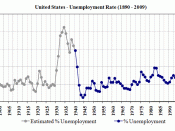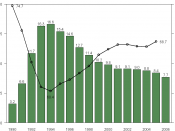Unemployment is broadly defined as the condition of not having a job, in other words being "out of work". Though, a more comprehensive understanding defines unemployment as the extent of individuals within an economy or society that are actively seeking work but are unable to obtain it.
Under the Labour Force Survey (LFS) guidelines, all people aged 16 and over can be classified into one of three states:UnemployedEmployedEconomically inactiveThe term unemployment is classified into two sections of conditions an individual is subjected to:Being without a job; wanting a job; have actively sought work in the last 4 weeks and are available to begin work in the next 2 weeks.
Being out of work, have found a job and are waiting to start in the next 2 weeks.
To be regarded as employed, an individual must carry at least one hour's paid work in a week, or who is temporarily away from a job.
Economically inactive refers to those who do not correspond into the criteria of unemployment and are not involved in any sort of job. Typically employment includes only work done for monetary gain. Hence, a homemaker, a full-time student or a prisoner is not considered as a part of the labour force or unemployed, and will therefore be regarded as inactiveHow Unemployment is Measured:The unemployment rate is the most used measurement of the level of unemployment in an economy. This is because it allows unemployment to be interpreted in the context of other changes. In particular, movements can be seen in the light of changes in the population and in the economic activity.
Unemployment Rate=(Unemployed Workers)/(Total Labor Force)ÃÂ100%Analysis of the Formula:The 'labour Force' (or work force) represents the people who supply labour for an economy. In the US, the labour force is defined as people 16 years of...


